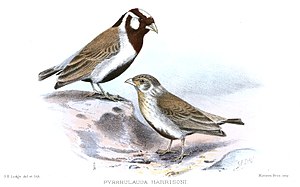Harlequin lark
| Harlequin lark | ||||||||||||
|---|---|---|---|---|---|---|---|---|---|---|---|---|

Harlequin lark, on the left the male, on the right the female |
||||||||||||
| Systematics | ||||||||||||
|
||||||||||||
| Scientific name | ||||||||||||
| Eremopterix signatus | ||||||||||||
| ( Oustalet , 1886) |
The harlequin lark ( Eremopterix signatus ) is a species from the lark family. It is a very small, finch-like lark with a thick, short beak. It is about 35 percent smaller than a skylark . Their distribution area is in the east of Africa. There are two subspecies. Together with the white-fronted lark, it may form a super species .
The IUCN classifies the harlequin lark as harmless ( least concern ).
features
The harlequin lark reaches a body length of about 11.5 to 12 centimeters, of which 4.3 to 5.6 centimeters are on the tail. The beak measures 1 to 12.5 centimeters measured from the skull. It weighs around 15 to 16 grams. There is a pronounced gender dimorphism .
In the male, the head, chin and throat are maroon. There is a large white spot in the middle of the vertex. The cheeks and the ear covers and the back of the neck are also white. A dark brown band runs on the upper coat. The rest of the top of the body is sand-colored to brown. The chest and abdomen are dirty white. A wide chestnut-colored band runs from the throat to the under tail-coverts. The feathers of the wings are brown, the inner hand wings and all arm wings are lined with light. The tail plumage is brown, the middle pair of control feathers is slightly lighter and lined with reddish brown at the end. The sixth (outermost) control spring has a white outside flag and the inside flag is also white in the last third. The beak is light gray to whitish. The iris is brown.
The female is basically similar in color to the male, but the chestnut-colored markings are missing. The face is indistinctly broken, the cheeks and ear covers are not white, but gray-brown. The underside of the body is dirty-white with dark lines in the middle of the abdomen. The coloring of the wings and the tail plumage corresponds to that of the male.
Young birds initially resemble the adult female.
Possible confusion
The male is not to be confused with any other species of lark in the range due to its high-contrast drawing and, above all, the large vertex. The similarly drawn males of the nun lark do not occur in the distribution area. The females resemble those of the white-cheeked lark . However, they are brighter overall.
Distribution area of the subspecies and habitat
There are two subspecies:
- E. s. harrisoni - ( Ogilvie-Grant , 1900) : Occurrence from the south-east of Sudan to the north-west of Kenya.
- E. s. signatus - ( Oustalet , 1886) : Occurrence in the south and east of Ethiopia, Somalia and in the east of Kenya.
The harlequin lark is quite a common bird in the entire range, but the white-fronted lark belonging to the same genus is more common.
The habitat are stony deserts sparsely populated with bushes and short-grass semi-deserts. It hardly occurs at altitudes above 2000 meters.
Way of life
The harlequin lark mainly eats grass seeds. Nestlings are also sometimes fed insects. The harlequin lark finds its food exclusively on the ground. Outside of the breeding season it occurs in groups of up to 40 individuals. It is then also associated with the white-fronted lark and the white-cheeked lark. When singing, the male does not rise higher than about six to ten meters.
Like all larks, the harlequin lark is a ground breeder. The breeding season falls from April to July. The nest is a typical, bowl-shaped lark's nest that is built next to tufts of grass or stones. The clutch consists of three to five eggs.
literature
- Rudolf Pätzold : The larks of the world . Westarp Sciences, Magdeburg 1994, ISBN 3-89432-422-8 .
- Rudolf Pätzold: Compendium of Larks. All the larks on earth. Jan-Schimkat-Medienpublikation, Dresden 2003, ISBN 3-00-011219-7 .
